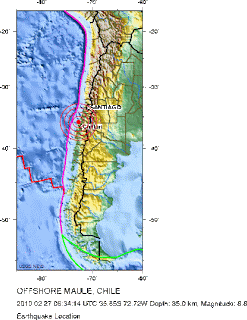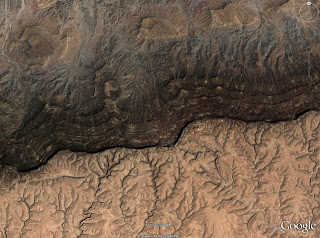I have decided to create a series of monthly posts/awards (...) in this blog where I will comment on blogs, websites and Twitters that I find both interesting and useful. I actually think I can find once a month a really good site. If I don't, or I just forget about it... well... Just let me know candidates!
So, here it goes the winner of February'10:
Ron Schott's website
Do you want to keep informed about what is going on in geology?
Do you want several updates a day?
Would you like to find interesting links about our favourite science?
If you have answer YES to at least one of the previous three questions, then you are interested in the blog and TWITTER of Ron Schott. Ron won last week (in an impressive couple of hours period) the "Where on (Google) Earth #187" that Dan suggested here, in StructuralGeology.org (Dan was sooo dissapointed... but his next image will be hard to find...)
If you don't know Ron, he is Assistant Professor of Geology at Fort Hays State University. Well, you better visit his personal website and you can find out more about him:
http://ron.outcrop.org/
His blog is great, by the way.
http://ron.outcrop.org/blog/
And, if you use twitter, you will just love his feeds:
http://twitter.com/RonsGeoPicks
By the way, Ron is an active user of the game "What on Google Earth". The "Schott rule", as you can imagine, is named after him. No wonder why... grrrr. And his last WOGE, number 188, is still waiting for your answer!!
Saturday, 27 February 2010
Earthquake in Chile, 8.8 Mw
 Chile has been shaken this night by a 8,8 Mw earthquake, as reported by www.usgs.gov (http://earthquake.usgs.gov/earthquakes/eqinthenews/2010/us2010tfan/#details). There is not much information so far. Bachelet, president of Chile, has reported 6 casualties already. USGS informs of potential several structural damages in central and southern Chile.
Chile has been shaken this night by a 8,8 Mw earthquake, as reported by www.usgs.gov (http://earthquake.usgs.gov/earthquakes/eqinthenews/2010/us2010tfan/#details). There is not much information so far. Bachelet, president of Chile, has reported 6 casualties already. USGS informs of potential several structural damages in central and southern Chile.The epicenter has been located at 35 km offshore Concepción, and Santiago de Chile, at more than 300 km, has been left in a blackout. In Valparaiso, the quake has been felt, but apparently no major damages have been reported.
Chile has been always, and will be, one of the most seismologically active areas in the world. In 1960 a 9.5 Mw earthquake devastated the region of Valdivia, killing 1655 people.
http://earthquake.usgs.gov/earthquakes/eqinthenews/2010/us2010tfan/#scitech
Thursday, 18 February 2010
Where on (Google) Earth? No. 187.
Having won the last round of Where on (Google) Earth it is my turn to suggest a location for others to find. The image below has an eye altitude of roughly 23km, and that’s all the help you lovely people get I’m afraid.
As with previous episodes, what we need to know is the Longitude and Latitude of the image, a general locality name and an explanation of the geological feature(s) shown. Also as with previous episodes, the first person with the correct answer gets to host the next edition.
Good Luck!

Tuesday, 16 February 2010
Podcasts in Geology
I like podcasts. They are a good companion at work, in the car or doing sports. But being a geologist, there is not much choice about what we can listen if we want something relating with our field of expertise.
Some years ago I discovered the “Corecast” of the USGS, but to be honest, it is quite light and … disappointing. The program is well done, is good, but only if you don’t know much of geology. Its target audience is the general public. Obviously that is fine because that is the task of the USGS: to educate general public about our work.
From time to time, in programs like “Radio 4 Choice”, of the BBC, they include content related with geology and this is great. But that doesn’t happen very often.
So, what do we have? Well, thanks to The Geological Society we have a few episodes of a geology podcast. Few means three so far! But their quality is quite good.
Sarah Day, the Earth Scientist Communicator of GSL, conducts the program where she interviews the speaker of the popular Shell Lectures, which are carried out on a monthly basis (montly…ish).
So far, the episodes are (description take from the GSL website):
Episode 3: The Present is the Key to the Past
- Listen to the podcast - 'The Present is the Key to the Past' (.mp3 11894 Kb)
Charles Lyell’s Principles of Geology was published between 1830-1833, and introduced the famous maxim, ‘the present is the key to the past’. Bruce Levell, Chief Geologist at Shell, explains the relevance of this principle to the oil and gas industry today, and why it might be hindering, rather than helping the search for energy resources.
One of the biggest consequences of our use of fossil fuels is its effect on sea level, which is continuing to rise. Is sea level rise natural, or are humans playing a part? And how can geologists help protect our coastlines? Lynne Frostick, Professor of Geography at the University of Hull and Geological Society President, explains what rising tides mean for our future, and how an understanding of our geological past can help us prepare for the future.
One of the biggest consequences of our use of fossil fuels is its effect on sea level, which is continuing to rise. Is sea level rise natural, or are humans playing a part? And how can geologists help protect our coastlines? Lynne Frostick, Professor of Geography at the University of Hull and Geological Society President, explains what rising tides mean for our future, and how an understanding of our geological past can help us prepare for the future.
Episode 2: Spider Webs and Seamounts
- Listen to the podcast - 'Spider Webs and Seamounts' (.mp3 10927 Kb)
Sarah visits Professor Martin Brasier at the University of Oxford, who made the news last month when he published reports of the world’s oldest fossilized spider webs. Preserved in amber dating back to the early Cretaceous, the webs are 135 – 140 million years old, and capture a crucial period in spider evolution.
November’s Shell London Lecturer, Professor Tony Watts, explains the importance of his research into sea mounts – mountains under the sea. Potential causes of geological hazards, they are also focal points of biological diversity. Earth Scientists remain divided as to their cause, with some critical of the increasingly prevalent ‘hotspot’ theory.
November’s Shell London Lecturer, Professor Tony Watts, explains the importance of his research into sea mounts – mountains under the sea. Potential causes of geological hazards, they are also focal points of biological diversity. Earth Scientists remain divided as to their cause, with some critical of the increasingly prevalent ‘hotspot’ theory.
Episode 1: Climate on Earth and Mars
- Listen to the podcast - 'Climate on Earth and Mars' (.mp3 10655 Kb)
In our very first podcast, Dr Matt Balme explains how he uses his knowledge of Earth to understand the Martian climate. And Dr Rosalind Rickaby tells of a tiny marine organism that’s facing a big climate challenge.
The ocean’s ability to absorb co2 is vital to reducing the impact of carbon emissions on climate. Approximately one quarter of Co2 emissions caused by human activity are absorbed by the ocean, which is becoming increasingly acidic as a result. By carrying out photosynthesis, marine phytoplankton such as the coccolithophore are an important part of this process, but can struggle to build their shells and skeletal structure as waters become more acidic.
Whilst the ‘paradigm view’ is that the ocean acidification will make it harder for the coccolithophore to build its calcium carbonate shell, recent research suggests they are in fact responding by calcifying even more. Understanding how these tiny marine organisms will respond to rising levels of atmospheric co2 is crucial to predicting how climate will evolve in the future
The ocean’s ability to absorb co2 is vital to reducing the impact of carbon emissions on climate. Approximately one quarter of Co2 emissions caused by human activity are absorbed by the ocean, which is becoming increasingly acidic as a result. By carrying out photosynthesis, marine phytoplankton such as the coccolithophore are an important part of this process, but can struggle to build their shells and skeletal structure as waters become more acidic.
Whilst the ‘paradigm view’ is that the ocean acidification will make it harder for the coccolithophore to build its calcium carbonate shell, recent research suggests they are in fact responding by calcifying even more. Understanding how these tiny marine organisms will respond to rising levels of atmospheric co2 is crucial to predicting how climate will evolve in the future
Besides, the GeolSoc.org.uk website also includes the links to the podcast of NERC Earth science, the Planet Earth series: http://www.geolsoc.org.uk/gsl/site/GSL/lang/en/page6262.html
A whole list of Planet Earth podcasts is available at: http://planetearth.nerc.ac.uk/multimedia/index.aspx
Enjoy the podcasting!
Wednesday, 10 February 2010
Microtectonics course in Mainz
If you are interested in microtectonics, then you know Passchier and Trouw and their classic textbook on that topic. Now you have the opportunity to enrol in a course in Mainz (where a large collection of microstructures is hosted) conducted by C. Passchier and D. Koehn.
Topics covered in the course are deformation mechanisms, veins and strain fringes, mylonitic fabrics and porphyroblasts. Participants are encouraged to bring their own thin-sections for discussions, in addition to the large collection available in the University of Mainz
Course fees are 280 euro, and will take place from Monday 29th of March to Thursday 1st of April of 2010. For further information, contact Sabine Fohrmann [fohrmann (at) uni-mainz (dot) de]. Appclations should be submitted before 1st of March of 2010.
(Information adapted from an email sent by Daniel Koehn to the Geo-tectonics mailing list)
Subscribe to:
Comments (Atom)
